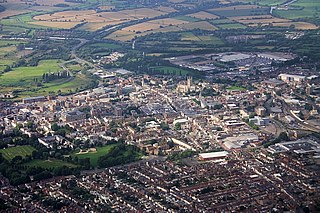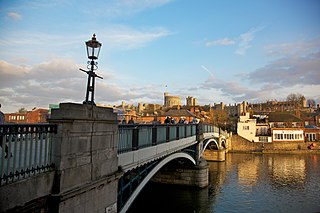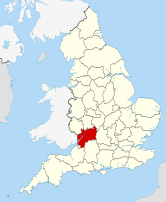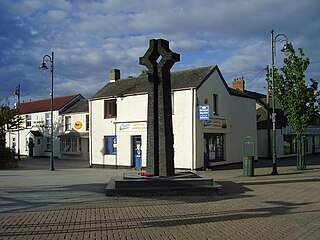
Caldicot is a town and community in Monmouthshire, southeast Wales, located between Chepstow and Newport on the Gloucester to Newport Line served primarily by Caldicot station, whilst by road it is just off the busy M4 / M48 motorway corridor. The site adjoins the Caldicot Levels, on the north side of the Severn Estuary. Caldicot has easy access on the railway west to Newport, Cardiff Central and east to Chepstow, Lydney, and Gloucester, as well as one stop west to Severn Tunnel Junction and then east via the Severn Tunnel to Filton Abbeywood and Bristol Temple Meads and further afield. Generally good road access to Cardiff and across the Second Severn Crossing, old Severn Bridge to Bristol. The population of the town is around 11,000. It has a large school, Caldicot Comprehensive School, and is known for its medieval castle.

Newent is a small market town and civil parish about 10.6 miles (17.1 km) northwest of Gloucester in Gloucestershire, England. Its population at the 2001 census was 5,073, increasing to 5,207 at the 2011 census. The town's site has been settled since at least Roman times and appears first in the historical record in the Domesday Book. It was a Medieval market and fair town.

Humphrey (IV) de Bohun was 2nd Earl of Hereford and 1st Earl of Essex, as well as Constable of England. He was the son of Henry de Bohun, 1st Earl of Hereford, and Maud FitzGeoffrey.
Miles FitzWalter of Gloucester, 1st Earl of Hereford, Lord of Brecknock was High Sheriff of Gloucester and Constable of England.

The Siege of Colchester occurred in the summer of 1648 when the English Civil War reignited in several areas of Britain. Colchester found itself in the thick of the unrest when a Royalist army on its way through East Anglia to raise support for the King, was attacked by Lord-General Thomas Fairfax at the head of a Parliamentary force. The Parliamentarians' initial attack forced the Royalist army to retreat behind the town's walls, but they were unable to bring about victory, so settled down to a siege. Despite the horrors of the siege, the Royalists resisted for eleven weeks and only surrendered following the defeat of the Royalist army in the North of England at the Battle of Preston (1648).
Henry FitzMiles, Baron Abergavenny was a Norman baron and a Marcher Lord in the Welsh Marches.
Walter of Gloucester was an early Anglo-Norman official of the King of England during the early years of the Norman conquest of the South Welsh Marches. He was a sheriff of Gloucester and also a Constable under Henry I.
This article is about the particular significance of the century 1101 - 1200 to Wales and its people.
Mahel de Hereford was a holder of the feudal lordships of Brecon and Abergavenny in the Welsh Marches in the mid 12th century.
Sibyl de Neufmarché, Countess of Hereford, suo jure Lady of Brecknock, was a Cambro-Norman noblewoman, heiress to one of the most substantial fiefs in the Welsh Marches. The great-granddaughter of Gruffydd ap Llywelyn, king of Wales, Sibyl was also connected to the nobility of England and Normandy. Sibyl inherited the titles and lands of her father, Bernard de Neufmarché, Lord of Brecon, after her mother, Nest ferch Osbern, had declared her brother Mahel to have been illegitimate. Most of these estates passed to Sibyl's husband, Miles de Gloucester, 1st Earl of Hereford, as her dowry. Their marriage had been arranged personally by King Henry I of England in the spring of 1121. Sibyl, with her extensive lands, was central to the King's plans of consolidating Anglo-Norman power in south-east Wales by the merging of her estates with those of Miles, his loyal subject on whom he relied to implement Crown policy.
Margaret of Hereford was an English noblewoman and the eldest daughter of Miles de Gloucester, 1st Earl of Hereford by his wife, the wealthy Cambro-Norman heiress Sibyl de Neufmarché. Margaret married Humphrey II de Bohun, by whom she had five children. Margaret held the office of Constable of England and as a widow, exercised lordship of Herefordshire until her own death. She was the benefactress of several religious institutions.
Clement of Llanthony was an Anglo-Norman monk and theologian who became prior of Llanthony Priory.
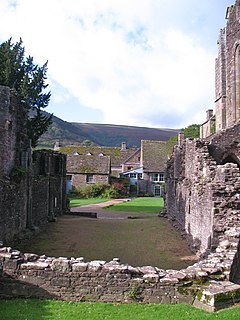
Court Farmhouse, Llanthony, Monmouthshire is a farmhouse of late medieval origins. It may have originally been lodgings for the Prior of Llanthony. Following the Dissolution of the Monasteries the building became a farmhouse. In the 19th century, the Llanthony Estate was bought by Walter Savage Landor who undertook remodelling. The farmhouse is Grade II* listed, with the adjacent barn, Court Farm Barn, having a separate Grade I listing.

High Orchard was an industrial area of the city of Gloucester in England that was developed in the 19th century on the former orchard of the Priory of Llanthony Secunda (1136). The area was closely associated with Gloucester Docks immediately to the north, and served by the Gloucester and Sharpness Canal and railway transport. It was the site of Fielding & Platt's Atlas Works and a number of other significant local employers.



